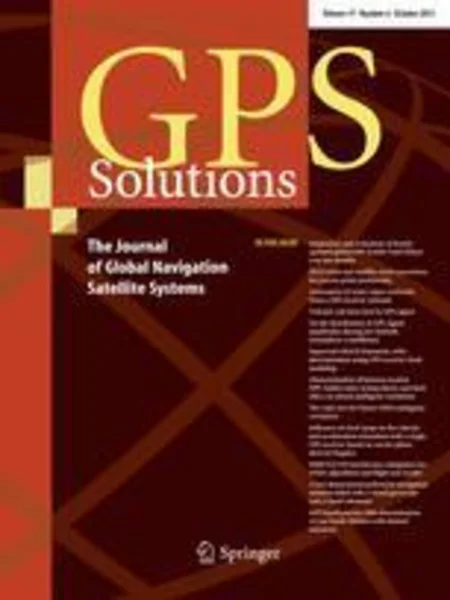-
a preliminary evaluation of the performance of multiple ionospheric models in low- and mid-latitude regions of china in 2010–2011
جزئیات بیشتر مقاله- تاریخ ارائه: 1392/07/24
- تاریخ انتشار در تی پی بین: 1392/07/24
- تعداد بازدید: 1262
- تعداد پرسش و پاسخ ها: 0
- شماره تماس دبیرخانه رویداد: -
ionospheric delay is a dominant error source in global navigation satellite system (gnss). single-frequency gnss applications require ionospheric correction of signal delay caused by the charged particles in the earth’s ionosphere. the chinese beidou system is developing its own ionospheric model for single-frequency users. the number of single-frequency gnss users and applications is expected to grow fast in the next years in china. thus, developing an appropriate ionospheric model is crucially important for the chinese beidou system and worldwide single-frequency beidou users. we study the performance of five globally accessible ionospheric models global ionospheric map (gim), international reference ionosphere (iri), parameterized ionospheric model (pim), klobuchar and nequick in low- and mid-latitude regions of china under mid-solar activity condition. generally, all ionospheric models can reproduce the trend of diurnal ionosphere variations. it is found that all the models have better performances in mid-latitude than in low-latitude regions. when all the models are compared to the observed total electron content (tec) data derived from gim model, the iri model (2012 version) has the best agreement with gim model and the nequick has the poorest agreement. the rms errors of the iri model using the gim tec as reference truth are about 3.0–10.0 tecu in low-latitude regions and 3.0–8.0 tecu in mid-latitude regions, as observed during a period of 1 year with medium level of solar activity. when all the ionospheric models are ingested into single-frequency precise point positioning (ppp) to correct the ionospheric delays in gps observations, the pim model performs the best in both low and mid-latitudes in china. in mid-latitude, the daily single-frequency ppp accuracy using pim model is ~10 cm in horizontal and ~20 cm in up direction. at low-latitude regions, the ppp error using pim model is 10–20 cm in north, 30–40 cm in east and ~60 cm in up component. the single-frequency ppp solutions indicate that nequick model has the lowest accuracy among all the models in both low- and mid-latitude regions of china. this study suggests that the pim model may be considered for single-frequency gnss users in china to achieve a good positioning accuracy in both low- and mid-latitude regions.
مقالات جدیدترین رویدادها
-
استفاده از تحلیل اهمیت-عملکرد در ارائه الگوی مدیریت خلاقیت سازمانی و ارائه راهکار جهت بهبود
-
بررسی تاثیر ارزش وجوه نقد مازاد بر ساختار سرمایه شرکت های پذیرفته شده در بورس اوراق بهادار تهران
-
بررسی تأثیر سطح افشای ریسک بر قرارداد بدهی شرکت های پذیرفته شده در بورس اوراق بهادار تهران
-
بررسی تأثیر رتبه بندی اعتباری مبتنی بر مدل امتیاز بازار نوظهور بر نقد شوندگی سهام با تأکید بر خصوصی سازی شرکت ها
-
تأثیر آمیخته بازاریابی پوشاک ایرانی بر تصویر ذهنی مشتری پوشاک ایرانی (هاکوپیان)
-
ایفای نقش it در آموزش ریاضی
-
مکانیابی بهینه ایستگاه های آتش نشانی با استفاده از مدل ahp با رویکرد پدافند غیرعامل ؛نمونه موردی، شهر بهبهان
-
بررسی عددی جانمایی ماده منفجره با توجه به شبکه آرماتور بر میزان تخریب در دال بتن مسلح
-
بررسی تأثیر اکسیژن درمانی تکمیلی بر میزان بروز و شدت تهوع و استفراغ بعد از عمل جراحی سزارین به روش بی حسی نخاعی
-
ارزیابی روش های مختلف فیزیکی شیمیایی نمک زدایی و انتخاب گزینه برتر جهت بهبود کیفیت آب های زیرزمینی (مطالعه موردی: آب چاه های بهارستانی تربت حیدریه)
مقالات جدیدترین ژورنال ها
-
مدیریت و بررسی افسردگی دانش آموزان دختر مقطع متوسطه دوم در دروان کرونا در شهرستان دزفول
-
مدیریت و بررسی خرد سیاسی در اندیشه ی فردوسی در ادب ایران
-
واکاوی و مدیریت توصیفی قلمدان(جاکلیدی)ضریح در موزه آستان قدس رضوی
-
بررسی تاثیر خلاقیت، دانش و انگیزه کارکنان بر پیشنهادات نوآورانه کارکنان ( مورد مطالعه: هتل های 3 و 4 ستاره استان کرمان)
-
بررسی تاثیر کیفیت سیستم های اطلاعاتی بر تصمیم گیری موفق در شرکتهای تولیدی استان اصفهان (مورد مطالعه: مدیران شرکتهای تولیدی استان اصفهان)
-
ارزیابی نقش مدیران شهری در مدیریت بحران
-
ارتباط منظر و نمای شهـری با مؤلفه های ژئوپلیتیک و قدرت سیاسی شهری
-
تحلیلی بر علل و عوامل کاهش انگیزه و تأثیر آن بر افت تحصیلی دانش آموزان
-
رابطه بین تیپ های شخصیتی با شادکامی و عزت نفس در بین دانشجویان دانشگاه امام جواد(ع) شهر یزد
-
the impact of mck+ prangkuti luhur towards the improvement of community life quality in bustaman village




سوال خود را در مورد این مقاله مطرح نمایید :